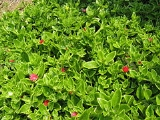
Aptenia cordifolia
Encyclopedia

Succulent plant
Succulent plants, also known as succulents or fat plants, are water-retaining plants adapted to arid climates or soil conditions. Succulent plants store water in their leaves, stems, and also in roots...
in the iceplant family
Aizoaceae
The Family Aizoaceae or Ficoidaceae is a taxon of dicotyledonous flowering plants containing 135 genera and about 1900 species. They are commonly known as stone plants or carpet weeds. Species that resemble stones or pebbles are sometimes called mesembs...
known by the common names heartleaf iceplant and baby sun rose. Perhaps the most common plant seen under this name is actually Aptenia 'Red Apple', a hybrid with red flowers and bright green leaves, whose parents are A. cordifolia and A. (Platythyra) haeckeliana. The true species of A. cordifolia has magenta purple flowers and more heart-shaped, mid-green, textured leaves.
Native to southern Africa
Southern Africa
Southern Africa is the southernmost region of the African continent, variably defined by geography or geopolitics. Within the region are numerous territories, including the Republic of South Africa ; nowadays, the simpler term South Africa is generally reserved for the country in English.-UN...
, this species has become widely known as an ornamental plants. This is a mat-forming perennial herb growing in flat clumps on the ground from a woody base. Stems reach up to about 60 centimeters long. The bright green leaves are generally heart-shaped and up to 3 centimeters long. They are covered in very fine bumps. Bright pink to purplish flowers appear in the leaf axils and are open during the day. The fruit is a capsule just over a centimeter long.
The hybrid, A. 'Red Apple', has, in some areas, escaped cultivation and now grows as an introduced species
Introduced species
An introduced species — or neozoon, alien, exotic, non-indigenous, or non-native species, or simply an introduction, is a species living outside its indigenous or native distributional range, and has arrived in an ecosystem or plant community by human activity, either deliberate or accidental...
. Its far more vigorous growth and ability to root from small bits of stem makes it a poor choice for planting adjacent to wild lands.

